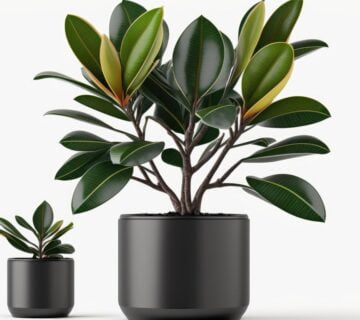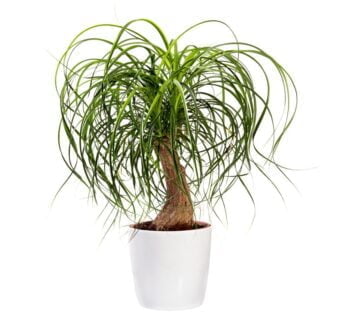Song of India
Song of India, also known as Dracaena reflexa, is a popular ornamental houseplant that belongs to the Dracaena genus. It is native to Madagascar, Mauritius, and other Indian Ocean islands.
Description:
Song of India is a slow-growing, evergreen shrub or small tree with a bushy growth habit. It features long, arching stems and lance-shaped leaves that are glossy, deep green in colour, and have a distinctive yellow or lime-green stripe running along the centre. The leaves are arranged in a spiral pattern, giving the plant an attractive and tropical appearance.
Popular varieties:
There are several cultivars of Dracaena reflexa, each with slight leaf colour and pattern variations. Some popular varieties include ‘Variegata’ (with white and green striped leaves), ‘Anita’ (with pinkish hues), and ‘Pleomele’ (a compact form with broader leaves). These cultivars add diversity and visual interest to indoor spaces.
Indoor cultivation:
Song of India is widely grown as a houseplant due to its attractive foliage and low maintenance requirements. It thrives in bright, indirect light but can tolerate some degree of shade. It is best to avoid direct sunlight, as it may scorch the leaves. The plant prefers temperatures between 60-75°F (15-24°C) and should be protected from drafts.
Watering and humidity:
Like most Dracaena species, Song of India prefers moderate watering. It is essential to let the soil dry out partially between waterings to avoid overwatering, which can lead to root rot. During the growing season, water the plant when the top inch of the soil feels dry. Reduce watering in winter when growth slows down. Song of India appreciates moderate humidity levels, so misting the leaves or using a humidifier can be beneficial, especially in dry indoor environments.
Soil and fertilization:
Use a well-draining potting mix that retains some moisture but allows excess water to drain away. A mix of peat moss, perlite, and sand works well. Fertilize the plant during the growing season (spring and summer) with a balanced houseplant fertilizer diluted to half the recommended strength. Avoid overfertilizing, as it can cause leaf burn.
Pruning and propagation:
Pruning Song of India can help maintain its shape and encourage bushier growth. Remove any yellow or damaged leaves and trim back overgrown stems to promote a more compact form. The plant can be propagated through stem cuttings. Take 4-6 inch (10-15 cm) cuttings from healthy stems, remove the lower leaves, and place them in a well-draining potting mix. Keep the cuttings in a warm, humid environment until they develop roots.
Toxicity:
It is important to note that Song of India is toxic to pets, including cats and dogs. Ingesting the plant’s leaves or stems can cause digestive issues and discomfort. Keep it out of reach of pets and children.
The Song of India plant is often used in feng shui practices. According to feng shui principles, the plant is thought to bring good luck and prosperity to the home or office.
Song of India is prized for its ornamental value and is commonly used as a decorative accent in homes, offices, and other indoor spaces. With proper care, it can thrive for many years, adding a touch of tropical elegance to your surroundings.
Things to know about Song of India
Common (vernacular) Name
विंका (Hindi), Vinca, Sadabahar, Madagascar Periwinkle, Catharanthus Roseus, Nityakalyani, Bara Massi, Bright Eyes, Cape periwinkle, Graveyard Plant, Old maid, Pink Periwinkle, Rose Periwinkle, and many more.
Botanical Name
Catharanthus roseus
Origin
Island of Madagascar
Family
Apocynaceae
Plant Type
Tropical plant
Plant Features
Ornamental / Evergreen / Exotic
Life Cycle
Perennial
Landscape Uses
Container, Walkways, Ground Cover, Mass Planting and Houseplants.
Species
Apricot Cooler Improved, Aztec Pink Magic, Blue Pearl, Cascade Beauty White, Cooler Icy Pink, Cooler Orchid, Cooler Peppermint, Cora Burgundy, Cora Cascade Cherry, Cora Cascade Strawberry, Cora Red, Experimental Dee, Jams and Jellies, Mediterranean Lilac, Mediterranean XP Cherry Halo, Mediterranean XP Rose Halo, Nirvana Pink Blush, Nirvana Red, Nirvana Sky Blue, Nirvana Violet, Pacifica White, Sunshower Lilac, Titian Icy Pink
Varieties
It comes with more than 30 varieties in various leaf and flower colourations.
Size
Height : 1 to 1.5 feet tall and Width : 1 foot wide when mature.
Indoors or Outdoors
Outdoors : Anthurium can be used outdoors in shady plantings; avoid direct sunlight.
Indoors : Excellent plant growth in bright light or indirect light. Best indoor plants for beginners.
Blooming / Flowering
The blooming period is throughout the year.
Flower Colour
It’s come in Pink, White, Purple, Red and Multicoloured.
Lucky Plant
According to Feng Shui, It brings Good Luck in your relationships.
Lighting / Sun Exposure
Bright Indirect Sunlight.
Temperature
Grow best in warm temperatures above 21°C and tolerate max temp. as high as 32°C.
Growth Rate
Anthurium is a slow to moderate grower plant.
Watering
Moderate watering, Mist or overhead sprinkler to provide water and to improve relative humidity. Do not tolerate overwatering, It can cause root damage and leaf yellowing.
Fertilizer
Applying slow-release fertilizer or a water-soluble liquid fertilizer once or twice during the growing season (from spring to summer) is recommended.
i.e., - Cow dung, DAP, Compost, NPK 30-10-10 fertilizer, liquid organic fertilizer etc.
Pruning
Pruning of Anthurium, little is needed. However, trimming away only discoloured or dead leaves.
Propagation
Seeds : The best time to sow your Anthurium seeds is at the end of Winter / early Spring, but it can't give good results.
Stem Cuttings : The easier propagation methods of Anthurium in water or soil via stem cuttings can be done during the warm growing season.
Division : The division of Anthurium can be done in the Rainy season or, better, from February to March.
Dormancy Period
Month : November to February (winter season)
Shed their leaves and show poor growth, Watering minimally.
Avoid : Propagate, Fertilize and Repotting.
Container
Ceramic Pot, Plastic Pot, Terracotta or Clay Pot is preferred, which ensures good drainage and water holding capacity.
Soil Type
A well-drained Loam / Coarse potting soil and water-holding capacity are recommended. Prevent soggy potting medium.
Our recommendation for the potting mix: Equal part mixture of Garden Soil (25%) + Compost (25%) + River Sand (25%) + Cocopeat (25%). You can substitute pieces of Charcoal, Vermicompost, Perlite etc.
Soil pH
Lightly Acidic soil - Ideally, 5.5 to 6.5 pH (potential of hydrogen) is recommended for Anthurium.
Repotting
It is advisable to repot the Anthurium every year or two, preferably during the spring to midsummer season.
Maintenance
Low maintenance and easy to grow.
Properties
The plant poses toxicity risks to both humans and pets if ingested.
Benefits
Excellent indoor air purifier, Anthurium plants turn CO2 into oxygen. It purifies indoor air by removing harmful chemicals like ammonia, toluene, xylene and formaldehyde.
Special Features
It does not attract hummingbirds and pollinators in the same way it does butterflies, bees, or wasps.
Infestation / Pests
Aphids, Scale insects, Thrips, Mealybugs, Spider mites, caterpillars etc.
Diseases / Problem
Physiological Problem : Anthracnose, Leaf Spot and Powdery Mildew.
Bacterial Problem : Bacterial Blight, Bacterial Wilt and Black Nose Disease.
Fungal Problems : Root Rot and Water Mold.
In conclusion, Vinca or Sadabahar plants are prized for their beautiful flowers, easy maintenance, and versatility in various garden settings. With their vibrant colours, heat tolerance, and ability to attract pollinators, they can bring joy and visual interest to any garden or landscape.
Some Glimpse of Song of India





No comment